Easter in Spain with Limousine CC
Easter in Spain
Spain has a long tradition of Easter. Easter is a celebration that has been maintained over the centuries, mixing religious fervor with art, history and an indisputable aesthetic value.
There is no town or city that is outside this tradition so famous in Spain. We will comment on some of these cities:
Lorca
What really makes this Easter special is the way of life that has the city of Lorca, totally overturned with 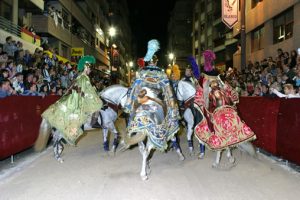 two of its main brotherhoods (Paso Blanco and Paso Azul) and rivalry that forces both to try to overcome the contrary in such a way That art and tradition have been brought to their maximum splendor.
two of its main brotherhoods (Paso Blanco and Paso Azul) and rivalry that forces both to try to overcome the contrary in such a way That art and tradition have been brought to their maximum splendor.
The Old Testament scenes are depicted with large floats and spectacular horses groups.
The characters are adorned with pieces of embroidery handmade in silk and gold, inspired and staging events related to the character they characterize (some of these pieces are the first textiles declared in Spain Asset of Cultural Interest).
Zamora
It can be considered the paradigm of Easter in the north of the country. What is incredible is that their confraternities are made up of almost thirty-five thousand people, and all this in a city that has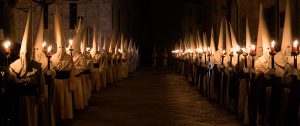 sixty-five thousand inhabitants, more than 50% of the population.
sixty-five thousand inhabitants, more than 50% of the population.
Holy Monday emphasizes the song of “Jerusalem, Jerusalem”, El Cristo de las Injurias and the oath of Silence in the atrium of the cathedral on Holy Wednesday. The brotherhood of the Vera Cruz celebrated on Holy Thursday, which is the oldest of Spanish Holy Week.
Malaga
During more than 500 years of history and uninterruptedly, Easter of Malaga has remained present in the religious and popular sentiment of the people of Málaga.
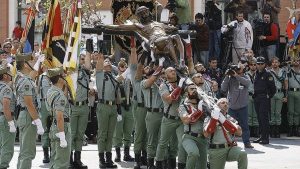 Most Brotherhoods and Brotherhoods of Passion have their own Brotherhood House, they are practically museums, where to visit and observe closely and in detail, the luxury and beauty of their thrones, virgin capes, equipment, utensils of liturgy and procession .
Most Brotherhoods and Brotherhoods of Passion have their own Brotherhood House, they are practically museums, where to visit and observe closely and in detail, the luxury and beauty of their thrones, virgin capes, equipment, utensils of liturgy and procession .
Highlight El Cautivo on Monday, La Virgen de la Paloma with live pigeons and the release of a prisoner without blood crime by Nuestro Padre Jesus el Rico every Holy Wednesday and the impressive Cristo de la Buena Muerte carried by the Legion.
Seville
Easter is the great festival of Seville. A celebration that reaches an aesthetic and spiritual intensity. Declared Festival of international tourist interest.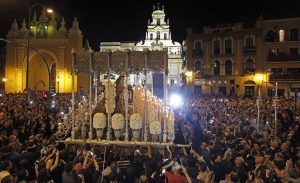
It is a tradition that the brotherhoods (about seventy), in different parts of the route, sing a saeta. (Typical Andalusian song).
The most crowded moment of Holy week in Seville is the departure of the Macarena, known as La Madrugá, the most intense and expected night of Easter. It is celebrated in the passage from Holy Thursday to Holy Friday, it is a tradition worth seeing and of being lived.
Murcia
Easter of Murcia is one of the most significant manifestations of the rich and colorful cultural heritage of Murcia. The artistic and spiritual dimension of its processions give it its own character. There is no other 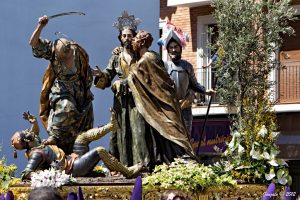 Spanish city in which the Nazarenes distribute sweets and gifts, reliving the times in which the members of the brotherhoods shared food for the most needy.
Spanish city in which the Nazarenes distribute sweets and gifts, reliving the times in which the members of the brotherhoods shared food for the most needy.
Holy Wednesday is one of the most anticipated days of the year, because, among other things, the whole city is awaiting the procession of the Real, Muy Ilustre, Venerable y Antiquísima Archicofradía de la Preciosísima Sangre de Nuestro Señor Jesucristo, a procession that the Murcia town baptized with the affectionate name of “the coloraos”. And do not forget the morning procession of Holy Friday, known as Los Salzillos of the Real y Muy Ilustre Cofradía de Nuestro Padre Jesús Nazareno, which fills the streets of Murcia with the magic sculpted in the works of the sculptor Francisco Salzillo.
Hellín
The best time of year to visit Hellín is undoubtedly at Easter. The Holy Week of Hellín is composed of two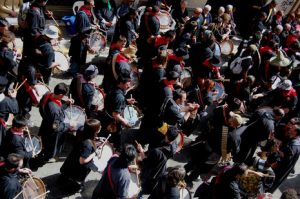 different parts: the processions and the tamborada. This festival is declared of international tourist interest.
different parts: the processions and the tamborada. This festival is declared of international tourist interest.
More than twenty thousand drummers, in black robes and red handkerchief, burst into the streets of Hellin at noon on Holy Wednesday. It is the first tamborada, which will follow the one of Friday of Dolores, accompanying the ascent and descent to the calvary of the Via Crucis of the Torches. The one of the Saturday of Glory begins at twelve at night, and the one of the Sunday of Resurrection before the twelve.
Cartagena
The Holy Week of Cartagena, declared of International Tourist Interest. It is the longest week of the year, with ten days of processions that extend from Friday of Dolores to Sunday of Resurrection.
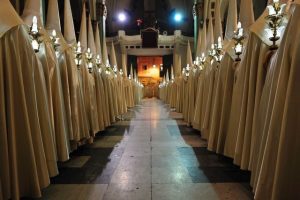 Almost all the processions leave and are collected in the same Church, Santa Maria de Gracia, located in the historical centre of the city.
Almost all the processions leave and are collected in the same Church, Santa Maria de Gracia, located in the historical centre of the city.
The processions are distinguished by the perfect order of their penitents who march to the sound of the drum in unison, walking and stopping all at once, remaining static in their stops. Next to this order, the flower and the light of the thrones and hachotes, as well as the music, are characteristic features of this Holy Week.
We could comment on the departure of the Via Crucis of the Cristo del Socorro, the Procession of piety, the Departure of San Juan Californio, parades of the encounter and departure of the Jesus and the collection of Amor Hermoso.
Elche
Easter is the main religious, cultural and traditional event that is lived in the streets of Elche. Each spring more than sixty thousand people are participants in the fervor that the thirty guilds carry through the streets of the city.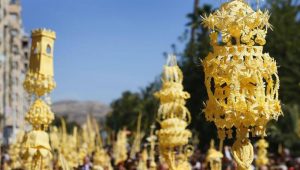
The celebrations of Easter in Elche begin with the procession of Palm Sunday, declared Fiesta of International Tourist Interest since 1997.
The main event of that day, the Procession of the Palms, acquires in Elche a special relief thanks to the amount of white palms, coming from the orchards of palm trees illicitanos, that the faithful carry.
This procession, which commemorates Christ’s triumphal entry into Jerusalem, has always had a great participation, becoming one of the most characteristic and multitudinous manifestations.
Granada
It was declared a Festival of International Tourist Interest, recognition that in Andalusia only share the Holy Week of Malaga and Seville.
To see the Christ of Silence or the Gypsy under the moonlight and with the Alhambra illuminated behind is undoubtedly a precious scene.
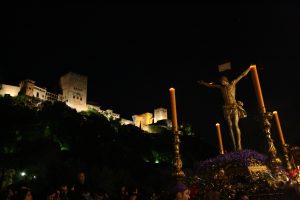 From noon until dawn, day after day the processions invade the city. No one wants to miss the sight of them passing through their neighborhoods. Huge fires are lit in the caves, dwellings and dwellings of the gypsies to the passage of the Cristo del Consuelo, known as the Cristo de los Gitanos “Christ of the Gypsies”.
From noon until dawn, day after day the processions invade the city. No one wants to miss the sight of them passing through their neighborhoods. Huge fires are lit in the caves, dwellings and dwellings of the gypsies to the passage of the Cristo del Consuelo, known as the Cristo de los Gitanos “Christ of the Gypsies”.
Many Grenadians decide to carry out the entire journey of their Brotherhood “cangrejeando”. That is, walking in front of the steps and turned back. Climbing the Sacromonte and follow the procession to the rhythm of the saetas sung through the balconies and terraces of the neighborhood is priceless. There are three days that are lived with special intensity. Wednesday, Thursday and Holy Friday.
Zaragoza
The Holy Week of Zaragoza is declared a Festival of International Tourist Interest and attracts 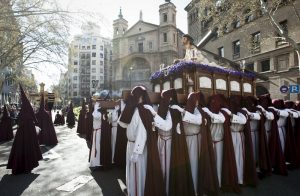 thousands of tourists every year who enjoy a week full of processions and religious events in the streets of Zaragoza.
thousands of tourists every year who enjoy a week full of processions and religious events in the streets of Zaragoza.
Holy Friday in the afternoon is the procession of the Holy Burial that gathers all the brotherhoods that are making their drums sound. It has been done for almost two hundred years by the brotherhood of la cofradía de la Sangre de Cristo. It is the only procession in Spain that has all the scenes of passion. Holy Thursday is one of the few places where a prisoner is released.
Castro Urdiales, Cantabria
This case is not a procession, as in previous places. Every year, on Holy Friday at 10 o’clock in the morning, the representation of the Living Passion of Castro Urdiales begins. From that moment until 6 hours later, the city becomes a stage where more than 600 neighbors revive the Passion of Christ.
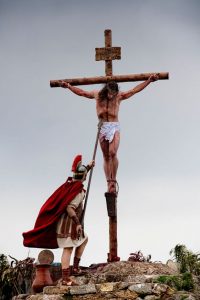 The festival is a representation of the Passion of Jesus Christ in which all details are taken care of, starting with the script, the decoration or the costumes. In the historical center of Castro Urdiales, the last hours of Jesus Christ are recreated emotionally.
The festival is a representation of the Passion of Jesus Christ in which all details are taken care of, starting with the script, the decoration or the costumes. In the historical center of Castro Urdiales, the last hours of Jesus Christ are recreated emotionally.
There are 15 scenes that are represented by the streets of the historical center of the City. Every year more than twenty thousand people come to witness the performance.
It does not matter if one is a believer or not, the fervor, respect and silence of the castrean avenues during the Passion, make it impossible not to shudder thanks to the quality and drama of the actors.
There are many other places to appreciate the beauty and the spectacular of the Holy Week in Spain, to mention the cases of Salamanca, Orihuela, Barcelona, Leon, Cuenca, Valladolid, Cáceres … and so on up to hundreds of places worthy of mention.
Share this story
